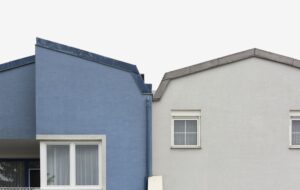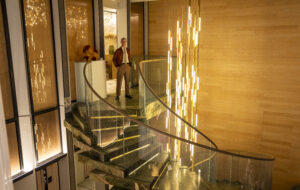

words Kieran Long
icon’s deputy editor Kieran Long has spent the past three months in Berlin, researching a book on architecture in the German capital. Here he reports on the city at the heart of the newly expanded European Union and identifies its leading architects.
Berlin is at once marginal and central to Europe. A key part both Western and Eastern psychological landscapes during the Cold War, since the fall of the Berlin Wall in 1989 it has been seen as a kind of blank canvas for architectural intervention and creation. In the 1990s it was rebuilt by the the energy and political will that came with its reinstatement as the capital of a united Germany. Meanwhile, it maintained its role as a location of anarchic cultural pursuit, with the romance of the squatting movement of the early 1990s and tales of illegal parties and guerilla galleries all over the city.
The city now finds itself in a double bind. It remains attractive to architects and artists, but it is bankrupt and one of the least prosperous of German cities, despite being the capital. On May 1, this prominence increased when ten new countries – Hungary, Poland, the Czech Republic, Slovakia, Slovenia, Estonia, Latvia, Lithuania, Malta and Cyprus – were admitted to the European Union. The redrawn map leaves Berlin at the very centre of Europe. The people of many of the ex-Soviet states identify with it as one of the major metropolises of Eastern Europe, and the hope is that it can harness this to become a place of exchange between east and west.
Berlin has immense caché as a style capital. Magazines regularly run articles about how Berlin is the home of the avant garde, the cradle of the edgiest in everything from contemporary music to fashion to visual art. They point to Berlin residents such as Canadian musician Peaches, American writer Jeffrey Eugenides, Icelandic artist Olafur Eliasson and others to prove their point. However, these people have, for the most part, been in Berlin a long time. The chancer architects who were swarming around the city in the 1990s have by and large gone home, and many artists have realised that although space is very cheap, there are no collectors to sell to. The city has been left with a fragmented and insecure cultural life, despite its incredible energy and diversity.
As a place to practice architecture, the perception of Berlin is very different from the reality. Many architects have visited the city as students or practitioners in the 1990s, and it seemed to many as the primal space for architecture to have an effect. Not only was it the former location of the Berlin Wall, what Alan Balfour called the “absolute architecture and the absolute contradiction of architecture – the purest monument to the divided soul of western man”, but also there were the temptations of it being the new capital of Europe’s biggest economy and the prestige projects that went with that – Potsdamer Platz, the Reichstag, the new embassies.
But soon these showpieces were finished, and the city ran out of money. As the German economy came to a grinding halt, so the possibilities for young and interesting offices getting work in Berlin decreased.
The glut of empty space in the city and its reputation – more than any other Western capital – of being a place where the normal boundaries between the legal and illegal occupation of space are blurred, might seem to provide obvious opportunities. However, there is immense conservatism at an administrative level. The controversial senatsbaudirektor Hans Stimmann, the building director for Berlin, has been personally responsible since the early 1990s for the aesthetics of new construction in the city.
He declared early in his career that the characteristic style of Berlin should be the typical stone- or render-faced, six-storey housing blocks that made up much of the 18th- and 19th-century city. This typological obsession came along with a stylistic enthusiasm for the work of post-rationalist architects such as Hans Kollhoff (architect of the famous Chicago-style brick tower at Potsdamer Platz). Stimmann stated that homogeneity was his goal, and that Berlin should conform to a single urbanistic vision – one of courtyards behind perimeter housing blocks, 22m eave heights and regular openings in facades.
The lack of really strong schools of architecture to form coherent theoretical opposition to this conservatism has meant that practices each have their stories of trying to build within Stimmann’s strict codes, or of trying to exist in the city while being outside of the group of practices favoured by the city authorities.
In this climate it is perhaps understandable, for instance, that British architect David Chipperfield now has one of the biggest offices in Berlin. The 55-strong practice has won many high-profile cultural commissions, many of them of such prestige that it is extraordinary that German practices were overlooked for the jobs. Apart from the much-trailed Museums Island masterplan, which connects the city’s finest and most prestigious collection of neoclassical buildings through an underground “archeological promenade”, he is also refurbishing Friedrich August Stüler’s Neues Museum, and will build a new entrance building next to it.
The fact that Chipperfield is an outsider in Berlin is a huge advantage. He is not implicated in the factional politics that rule the commissioning of large-scale buildings in Germany. Also, the cool modernism that characterises Chipperfield’s work has an appeal for sites that are politically or ideologically loaded. Chipperfield’s architecture is not ideologically neutral, but it is strongly tectonic, and perhaps can sustain the illusion of a mute monument in a country which still, perhaps surprisingly, is finding a distinct architectural voice difficult to find.
Despite the economic trouble and the city’s conservatism, young architects are still drawn to Berlin in huge numbers by the seduction of the thrillingly unique context in which to work, and by Berlin’s merited reputation as the most creative city in Germany. However, when they get here they often find that they have to generate their own projects.
As artist Christoph Hildebrand says, the middle classes are not as prevalent in the city, and the market for design and domestic architecture is therefore smaller than in cities like London: “After the wall the educated bourgeoisie was not in the city like in other West German cities. The big companies sent their representatives, but the main offices did not come.” Young architects have traditionally waited until they got a job in the formerly excellent German competition system. This system, though, is disintegrating, as clients get more conservative in the face of economic problems. Bob Niess, partner of Berlin architect Chestnutt Niess and member of the Architektenkammer Berlin competition commission says: “I have watched [competitions] become unfavourable. Clients are suspicious of them, and the specifications for qualifying for shortlists are increasingly draconian. Germany has a wonderful tradition of competitions, but it has become hollow, and is caving in.”
The competition system in Germany is not just suffering from the attitudes of clients, but also seems unable to draw the best from German architects. This year’s German Europan, normally an eclectic laboratory for new ideas in housing, was extremely disappointing, and was marked by pragmatism in young offices desperate for work.
Young practice Deadline is typically downbeat. Partners Matthew Griffin and Britta Jürgens say: “We’ve only done three or four competitions. The chances of getting anywhere with them are small. It’s like a lotto, except with no prize, because you don’t get to build it anyway.” Abcarius Burns, whose two mixed-use buildings on Joachimstrasse and Mulackstrasse offer loft-style flexible plans behind a louvred facade of subtlety, has also gone into development to be able to build. The partners also support themselves through teaching, as with many in the UK.
A big attraction to young practices is that the cultural scene for architecture in Berlin is extraordinary. Compared to London, which now has no independent architecture gallery, Berlin has four, all in private ownership, including the oldest in Europe, Aedes. Aedes, under the vigorous direction of former Netherlands Architecture Institute chief Kristine Feireiss, now has two sites, one in East Berlin in the Hackesche Höfe and another at Savignyplatz in the West. Aedes has presented shows in the last three months of Chinese and Korean architecture, and Feireiss thinks that Berlin needs to be more open to other influences. “Berlin is not the world,” she says, “One of our jobs is not to underestimate that influence, or the influence of our small world of architecture.”
Aedes curator Francesca Ferguson is another who thinks that the focus on Berlin has taken away attention from work going on outside of the high-profile capital. Ferguson is curating the German pavilion at the Venice Biennale this year, and the installation will consist of a huge photomontage, running like a ribbon through the pavilion, depicting a neglected landscape of suburban development, industrial hinterlands and other edge conditions that form an alternative to the obsession with making a new centre for a capital city. The title is Deutschlandschaft, or German landscape. “The projects we’ll be showing are less the prestige projects of the city centre, but this neglected sphere,” she says, “The project might be a remaking of a suburban house typology, twisted or cut in some way. There’s perhaps a more modest approach here than in the UK, but there’s a lot of good young offices. There’s so much reflection and probably not enough boasting.”
One of the projects Ferguson will be including in the German pavilion is a wonderful one-off house in Wandlitz by Heide von Beckerath Alberts, a young Berlin practice. The building takes a traditional housebuilder’s typology of the suburban bungalow, reorients it, and makes a three-storey house out of a given envelope. The cut in the house’s form accommodates a carport, bringing the car into the house, in a witty take on the lifestyle in these areas. The house inside is extremely flexible, and borrows ideas from their earlier competition-winning project for the Ideal German Home in 1996.
It is work like this that is engaging formally with the urban and suburban conditions of reunified Germany. The groundwork for some of this thinking began in the artistic field, with projects such as Sybile Kohl, Philipp Oswalt and Albrecht Schaefer’s “Verlassene Stadt”, which collated a catalogue of empty buildings in east Germany. These buildings could accommodate 2.3 million inhabitants, but are lying unused. This has also matured into research study, including Oswalt’s Shrinking Cities project, funded to the tune of €3.5 million (£2.33 million) by the German Cultural Foundation, and intended to investigate and propose solutions the problem of shrinking cities in Germany and abroad.
Berlin is and will remain Germany’s most creative hub, but its future resides in a longer-term expansion of Europe, aided by the unique working methods of the designers in the city. Mateo Kries, director of the Vitra Design Museum in Berlin, says: “In a place like Berlin you can still find something like an avant garde, if I may use that word, because it is it’s own microcosm in the design world. People work in small companies or on their own, but with a lot of networks internationally, and this is where innovations are made. Berlin has always been seen as a part of the European design world, and it is getting much more into the centre of attention. In the design scenes from Poland, the Baltic states and Slovakia, Berlin is a very important point of reference.”
Berlin is a wonderfully vibrant city, but the oft-cited instances of squatted buildings and innovation do not always reflect the often conservative situation of a city that, for example, has recently decided, at a cost of around €500 million, to reconstruct its 17th-century baroque palace, despite the fact that it was torn down more than 50 years ago. There is interesting work going on in Berlin, but it is often as much in spite of the city as caused by it. The focus of many of the best architects in Germany is as much directed towards the periphery of cities as it is to making a new capital for the nation, and although Berlin remains at the centre of international attention, it may have to open up further to become the architectural capital it wishes to be.
















